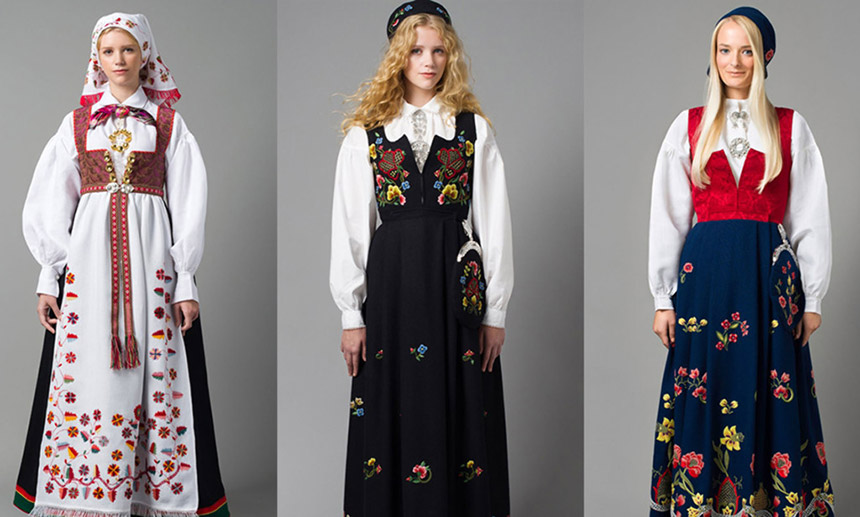
The colourful Norwegian folk dress has gained in popularity in recent years. We take a look at the history and the detail of the designs.
A bunad is a traditional folk costume that you find all over Norway. Although much more popular with women, men's bunads are also available.
The best time to see the outfit is on Norway’s national day, when the streets are full of bunad-wearing Norwegians of all generations! You may also people wearing one at weddings and other celebrations.
Table of Contents
A modern tradition
The smart, colourful outfits are made with wool, meant to be tight-fitting, and are adorned with metal buckles, buttons and jewellery. Accessories vary and can even include blades.
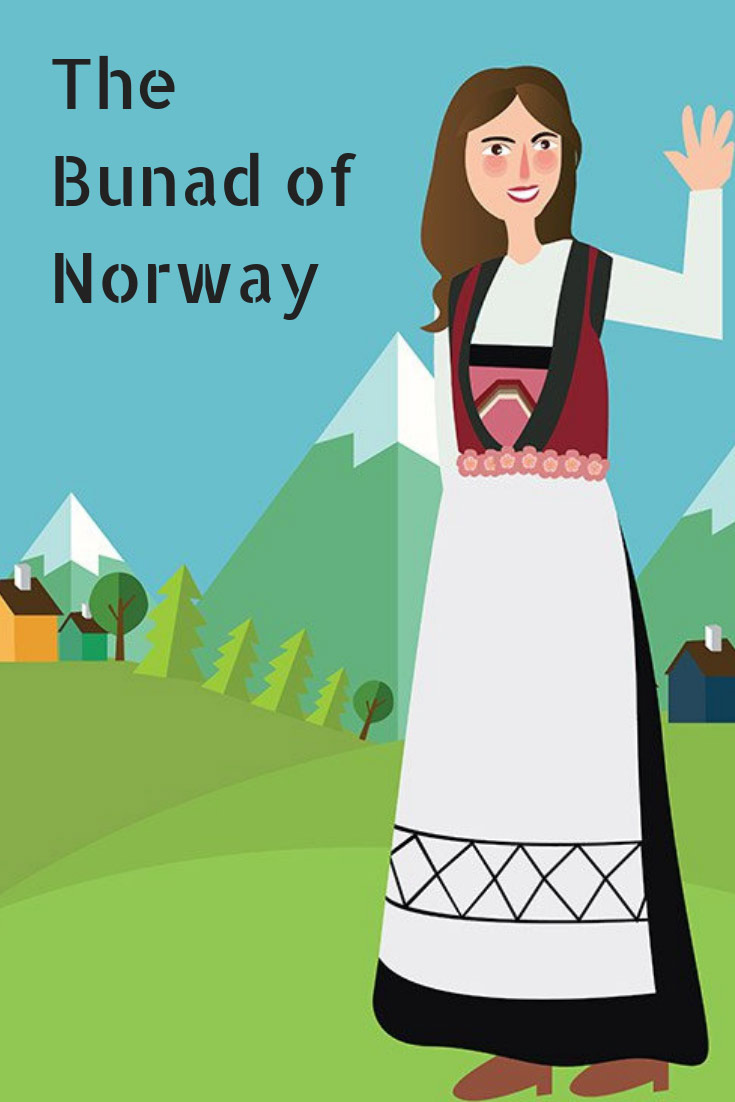
Although believed by many tourists to be a tradition dating back hundreds of years, that's not exactly true. Far from it in fact, as you can see from archive photographs from more than one hundred years ago.
The design of the modern bunad does take plenty of cues from traditional folk costumes dating back a few hundred years. However the modern dress we’re talking about in this article is very much a 20th-century invention.
While we’re on that subject, let’s take a look at how the costume came to be. For that, there’s one Norwegian woman to thank.
The mother of the bunad
The person most often credited with the outfit's ‘invention' – or at least rekindling interest in traditional folk costumes – is Hulda Garborg.
The writer, novelist, playwright, poet and dancer spent many years travelling the country participating in debates and promoting Norwegian culture. This was a tough job, as it was during the time when many families were leaving Norway in search of a better life in America or elsewhere.
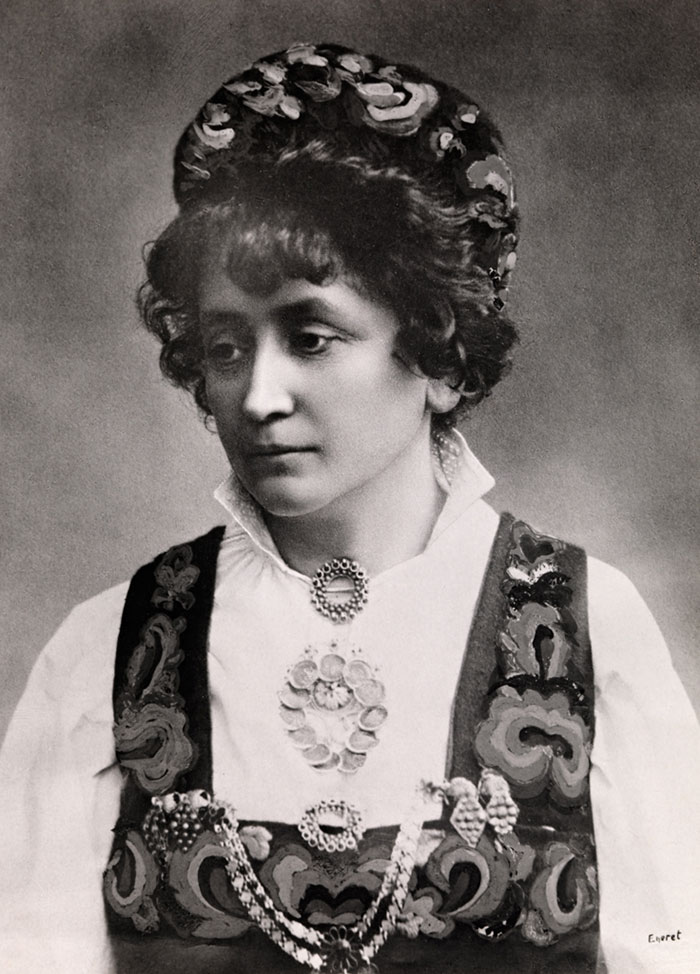
During the early-to-mid 1900s, Klara Semb took over the campaign and put the focus on developing “historically correct” bunads. Aagot Noss started to develop a written account of the traditions that modern bunads were based on in the 1950s.
When do Norwegians wear bunads?
Despite the wishes of some camera-wielding tourists, wearing a bunad is not something Norwegians do every day. Day-to-day, simple, practical clothing that suits the Norwegian climate is worn for work and regular social ocassions.
Since a bunad is a festival garment, less ornate traditional dress is more suitable and practical for work situations. Everyday cotton or wool costumes, colored and patterned shirts and aprons, and simpler silver accessories are among the possibilities.
However, the bunad does play an important role in a Norwegian’s major life events and special occasions.
Norwegians use it for various celebrations including weddings and possibly important birthdays and folk dances. It's also often worn on religious occasions such as baptisms, confirmations, and sometimes at Christmas.
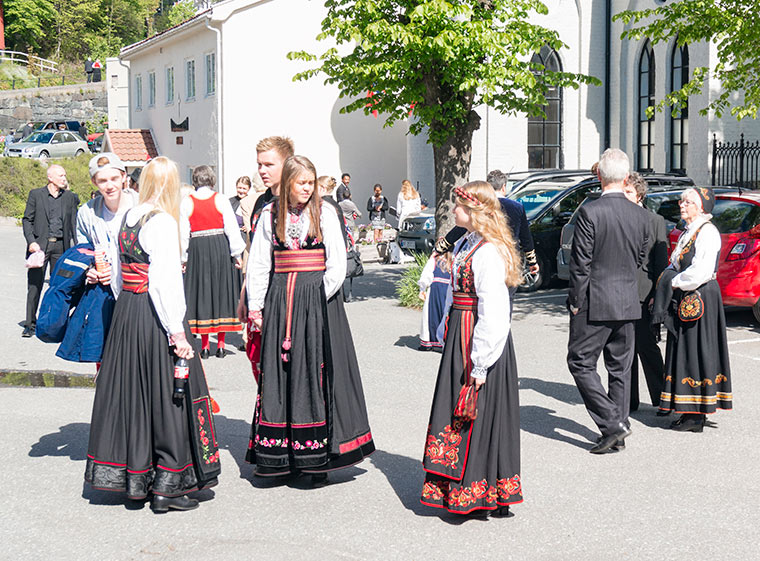
But without doubt the best day to admire the bunad out in public in Norway is on the 17th of May for the country's Constitution Day celebrations, when almost everyone dons the national dress.
Consider getting an everyday (hverdags) dress, which is less expensive and easier to make and care for. If fabrics are carefully chosen and workmanship is excellent, you will have appropriate clothing for traditional events.
The rules of the bunad
Designs vary massively between regions. One primary function of a person’s bunad is to serve as a public appreciation of and homage to your Norwegian heritage in general and to your town or region of Norway in particular.
It is customary to wear a bunad or folkedrakt from an area to which you have a genetic or residential connection. Then you won't have to explain to those who greet you (feeling they've found someone from their region) that you just liked that particular colour!
Your bunad should always display excellent quality fabric and workmanship. It should fit nicely, and be clean and in good repair. Staying in shape to fit in a bunad after many years can be quite the challenge!
Read more: On Wearing A Bunad For The First Time In 20 Years
Because you are wearing traditional (or traditionally related) clothing, conservative makeup and hairstyles are suitable.
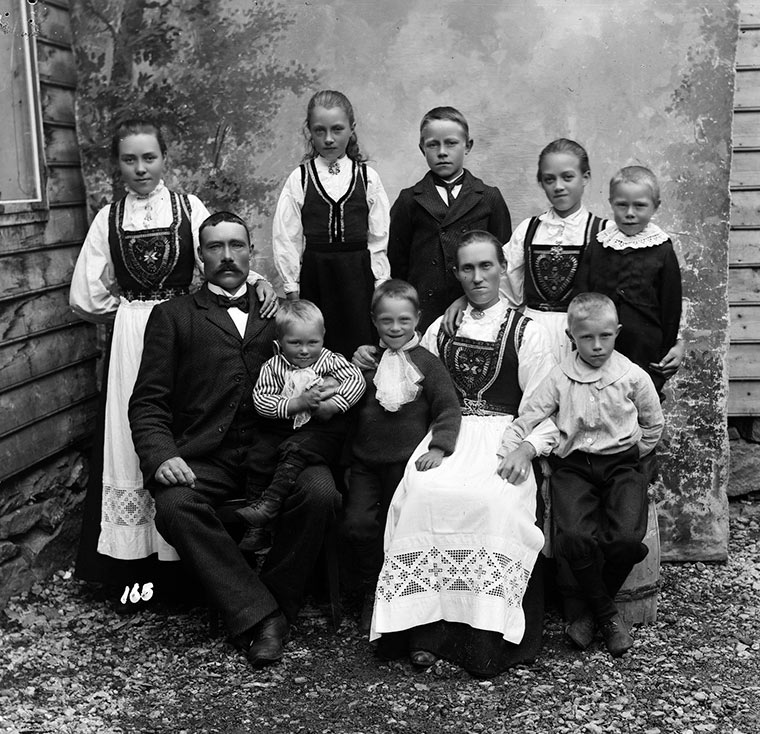
More contemporary additions such as earrings, high heels and nylons are out of place. References to the bunad police are made partly in jest!
Popular regional variants
One of the lesser known facts about the traditional dress is that there are a few hundred local varieties, with some saying there are up to 400.
That's quite a selection for a country of little more than five million people! Here are some of the most notable versions:
Nordland
One of the most popular regional variants is the Nordlandsbunad, from the county of Nordland. The men's version dating back to 1924 features dark blue stockings and a floral brocade vest over a stand-up collar shirt.
The female version is a rich blue dress with embroidered floral patterns on the skirt and top. Accessories include a shawl, apron, bag and a hat, all in blue of course. The Nordland outfit has regularly won the title “Norway's most beautiful bunad” from the Norwegian media.
Hardanger
Known as “the first bunad”, Hardanger's collection of designs vary in detail but are best known for their distinctive red body and white apron.
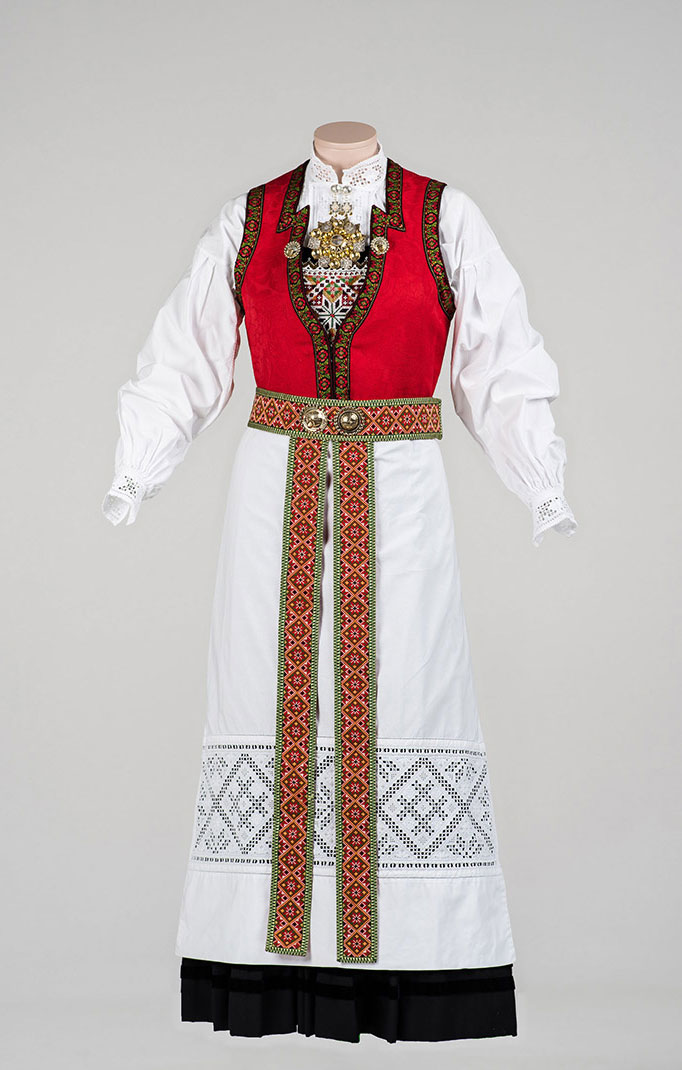
It is common to add a belt to the outfit at confirmation. According to tradition, the headgear worn depends on marital status.
Telemark
With a rich history in textile production and craftsmanship, Telemark in southern Norway is regarded by some as having the “Norwegianest” bunads.
Based on costumes from the 19th-century, Telemark's bunads differ between the west and the east, but at first glance appear similar: both feature a predominantly deep shade of blue, the same cut, and red/green embroidery.
Hallingdal (Buskerud)
The distinctive elements of the Hallingdal bunads include the contrast between the dark fabric and the vivid colours used in the embroidery.
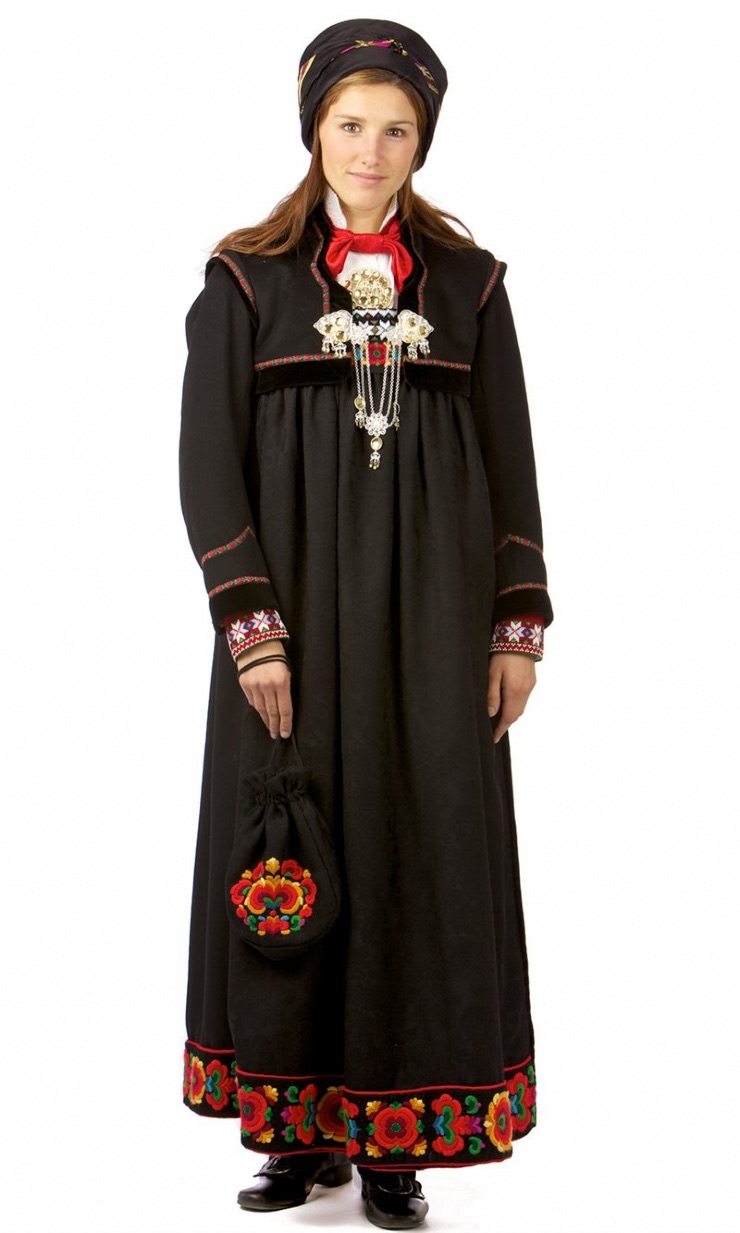
This bunad is designed without a belt, although one can be added if desired. Embroided headgear is also a common accessory.
Trøndelag
While different variations do exist within the vast region, the Trøndelag bunad was created in 1923 in an attempt to create a common bunad for the entire region of central Norway.
Inspired by Roccoco fashion from the 18th-century, it is one of the easiest to spot even though it can come in green, red or blue varieties, the latter being the most common.
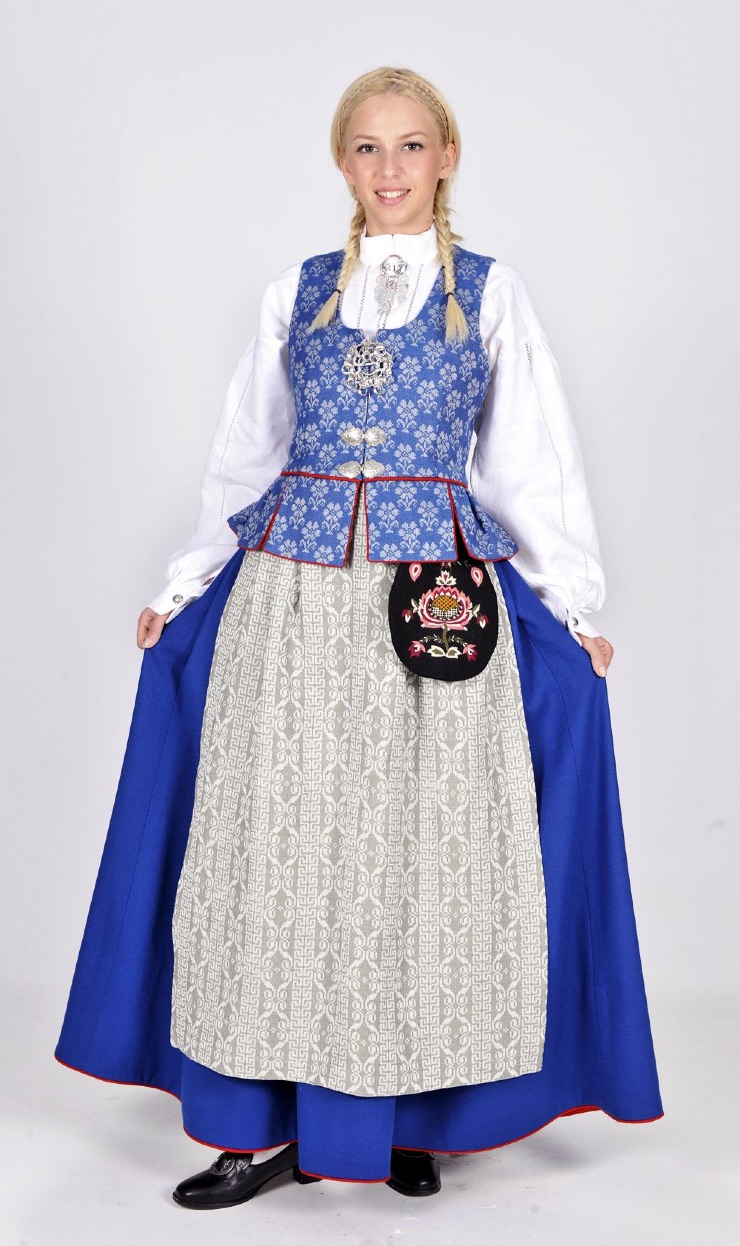
Bunad jewellery & accessories
Silver was (and still is, in some parts!) a very important material in Norway, steeped in superstition and legend. According to one legend, the silver mines belonged to the mountain trolls as they were such good silversmiths.
For many years silver was used by locals to protect themselves against bad weather and storms, to heal illness, and even to consecrate water. According to some stories, a silver brooch would often be pinned on the clothing of a baby so trolls couldn't swap the infant with one of their own!
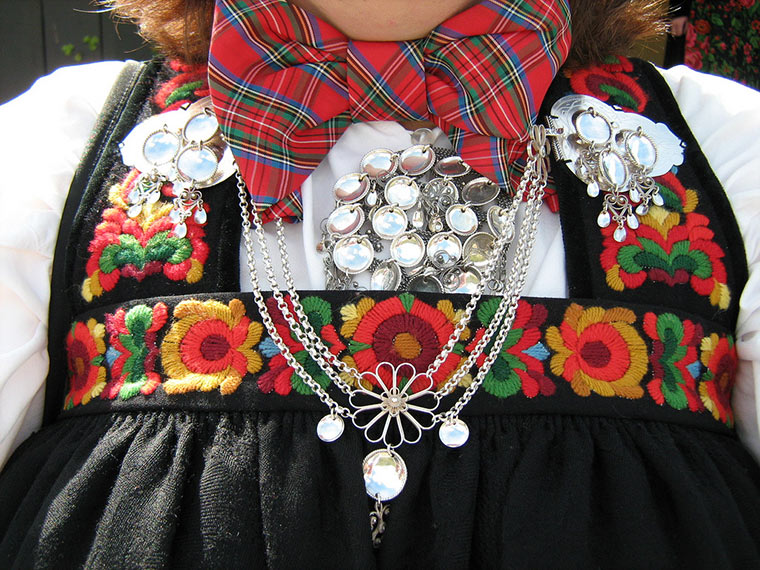
Because of this spiritual connection and ancestral value, pieces of silver were often handed down for generations within families.
As with the bunad itself, the design of the associated jewellery varies in design regionally. Some of the silver jewellery often found on a woman's bunad includes:
- Neck pin/button to hold the shirt together at the neck
- Brooch fastened across the front of the shirt rather than the bunad
- Accessories including cufflinks, shoe buckles, rings, and belts
Typically, less is more when it comes to accessorising the national costume.
FAQ: Frequently asked questions
We’re getting a lot of questions from this article! We’ll do our best to answer them in this section.
How expensive is a bunad?
This is without doubt the most frequently asked question!
A bunad is a complex and unique piece of clothing that’s designed and produced to last a lifetime. In this world of Asia-produced off-the-peg disposable clothing, it can be easy to forget what a truly handmade item of clothing costs to make.
Prices vary hugely, of course. A typical woman’s bunad made to order will likely cost in the region of 30-40,000 Norwegian kroner. Yes, that’s several thousand dollars.
For a more standard design that only needs minor adjustment, prices start from about 20,000 Norwegian kroner. That’s still a substantial investment, of course!
These days it’s also possible to buy a foreign-made bunad with less quality materials and craftsmanship. It’s going to be much cheaper, but it certainly won’t last lifetime.
Where can I buy a bunad?
You won’t find one in a Norwegian H&M or Cubus store! A bunad is almost always bought from a specialist store. There are independent stores, particularly in smaller counties and/or those that specialise in a specific type.
But there’s also a few national retailers with outlets in some of the bigger cities. They are also likely to have websites with more information or ranges, prices, ordering, etc. Ckeck out norskebunader.no and norskflid.no to begin with.
Any more questions?
Well, that’s all for now! The whole team at Life In Norway hopes you’ve learned something about this integral part of Norway’s culture.
We’re not sure we’re qualified to answer any questions, but feel free to ask a question anyway or leave a comment below. You never know who else is reading that may be able to provide an answer.


And to add; we are all wishing to have one if we dont 😁 next best is a folk costume lookalike…
These are party/wedding bunads. There is another kind that you CAN make yourself if you have any kind of sewing skills – it is called ‘hverdagsbunad’ or everyday [work] bunad. It is made of cotton in checkered material in the skirt, the top is usually one color, sometimes it in one piece fastened by the shoulder straps. And most importantly, a big ‘forkle’ or apron.
Let me know if you want to know more about this subject. I could dig out mine and send you a picture.
Hello, I want to know more. I am trying to make a bunad but I am having a problem fitting the bodice. Could you please email me? [email protected]
What is the Bunad of Tonsberg area? Thank you.
There are at least four different types that are called Vestfoldbunad. One is called Vestfoldbunad 1932 and is black or blue with a white a white shirt and a woven belt. Another is called Vestfoldbunad 1956. It is more colourful that the 1932 model with a red bodice and black or blue skirt. You may even have a white, embroidered apron. The belt is woven, or leather with silver “støler” on it. There is even an embroidered Vestfoldbunad which is called “den broderte vestfoldbunaden”. The last model is called “Tranum Røer”. It is very nice but not as widely used as the other three models. You can google all these models and find nice photos.
Hi, Linda,
Are you related to Linda Thorsen who lived in the community of Woodlawn in New York City in the 1950’s? I was in her class in school and would love to talk with her again. My email address is [email protected].
Sincerely,
Pat Shopland
I received the most marvelous gift from my beloved, his mother’s Hardanger bunad
from when she was a young woman….. It is my absolute treasure, and his sister
crafted the beaded vest, and belt……. Gorgeous, and I consider it an honor
to have received this.
Wow! That is special! My mother (from Stavanger) left her bunad behind when she came to the U.S. Years later she asked family back home to send it to her but somehow it was lost. What I wouldn’t give to have it, now that’s she’s passed away.
Very sad! If you go to Google and search for Rogalandsbunad you’ll find lots of photos. You can buy them- The cost would come up around 25000 Norwegian Kroner (US$3000) with should include the silver embellishment. – start saving!
It is possible to buy used bunads as well😊 Search Finn.no
Much cheaper.
And to correct the authers mistake, ther is only one specialist store that owns the original bunadsdesigns and that is Husfliden. They make quality! All others are fake. You can have them make it entirely for you or you can do what some families do, buy the original fabric there ( precut fabric) and have someone else do the sewing and embroidering.
Girls tha get confirmated often get a bunad as a gift for their confirmation
Thats why its sewn so it can be refit later on in life.
Not all of this is exactly correct, but the spirit of it is right.
Tønsberg is in Vestfold so it would be the Vestfold Bunad.
What an interesting essay and pictures. I do not have a bunad but do have a small silver pin, with silver discs that perhaps incorrectly we call the “wedding broach”. My daughter Kathy brought it back from Norway when she was an exchange teen through the Sins of Norway in 1975. I treasure it.
I’m guessing that’s meant to be “Sons of Norway” although “Sins of Norway” sounds appealing too!
I finally was able to purchase a bunad from Voss, where my great grandparents were from. I had been looking for TEN years. It is in fabulous condition, with the appropriate jewelry and a gorgeous silver belt. I only wish my Grandma was still alive to see it!!!
I would be interested in how you located a traditional made bunad. Thank you!
My Mama gave me her bunad before she passed away in 2010. She bought all the material and made her bunad by herself. The embroidery work is beautiful. Her family, fathers side, is from Egedall so she made it for that area of Norway. Again, it is gorgeous and she was very proud of it. I am so proud of it too. She made the hat and purse and along with her seulas it is complete! Thank you. Some of my spelling is incorrect.
My mama traveled to Norway four times and bought the material for her bunad there. I meant to write that in my comment above. Thanks, Irma Weaver.
My mother in law Signe Eriksen, was one of the group of Oslo women chosen to design a bunad for Oslo. As a city there was, at the time, no traditional bunad. The gorgeous blue dress with Signe’s wildflower embroidery is now the official Oslo bunad. Her own dress came to me when she died. Unfortunately it had been in her attic and was damaged bt moths. I took it and had pillows made of the material. I would love to know more of the story of how the dress was designed and the other women in the group.
That’s so cool! I recently found out that I have family from there and I’m trying to learn more about it; the Oslobunaden are so beautiful!
My great-grandparents emigrated from Skotselv. What bunad would be traditional for this area? Thank you?
It would probably be Nedre (“Lower”) Buskerud
https://www.bunadrosen.no/damebunad/nedre_buskerudbunad
My maternal Grandmother’s mother was from Hønefuss in Buskerud, and her father from Nord Aurdal in Valdres. My maternal grandfather’s parents were from Nor-Odal, just north-east of Oslo .Which would be the most expected District I choose the bunad from ?
I saw your post and had to tell you, I met my third cousin that lives in Honefoss! I also went to Sokna, then to my Grandfathers home in Hen! My Bunad is actually from Lillehammer..Ha en fin dag😎
I wonder if we are related, my Mother lived in Hen, most of the family is still in Honefoss and my Father and his parents came fron Sokna. I was born in Kongsberg. I have a Hardangef bunad, parts from Norway and my mother made the skirt for me.
My grandmother came to Vancouver Canada at the turn of the century, with her traditional dress from Sweden. When she passed away my mother passed her mother’s dress to me, the first born grand daughter. The dress includes her beautiful red and black handwoven twill floor length skirt and matching apron with long handwoven ties, handmade lined black broadcloth vest, silver pin and beautiful fine woolen floral fringe shawl. I am honored to be the caretaker of her dress for our family. Her family name was Boberg. They had a lumber mill on the edge of the North Sea, in the community of the now Skaftung Finland. Her niece Harriet and family still live there and care for the land there.
My Bestemor returned to Bergen in 1959 for her sisters golden anniversary. The family surprised her with a family made Hardanger bunad for me at, age 7. I wore it proudly ,marching in the 17th of Mai parade in Brooklyn ,NY as a child. It was made for a woman of 5’7″ ,however I grew into a 6′ woman, long waisted and it no longer fits. I also have a “Everyday bunad” which also no longer fits.I would love to have either on to proudly wear. Are there and patterns for long waisted women?
My family came from Torpa, in Land. It is west of Lillehammer, across the Mjøsa and in the valley. Does anyone know what style of bund comes from that area?
The Gudbrandsdalsbunad is a pretty safe bet. It comes in black and blue. Or there is the Axel Waldemar bunad, which comes in green as well. Both are embroidered and very pretty.
I’d recommend that you email the Husfliden shop closest to Torpa and ask what they say. There is one in Lillehammer and they should be able to advise you. Although this post mentions norskebunader.no I wouldn’t go to them. They are one of the manufacturers who outsource their production outside Norway, and you can tell by the quality. They also mostly do the “popular” versions of the bunads (and not all the bunads either), so they won’t have the local knowledge that Husfliden (norskflid.no) do.
On that side of Mjøsa it could be Hadelandsbunad. http://www.bunadtilvirkerne.no/hadeland-dame
It’s never been very popular, maybe because it isn’t as lavishly embroidered as many of the other bunads from the area.
My family in Namsos wear beautiful Trøndelag bunader! Whilst not Norwegian as such I’m surprised there is no mention whatsoever of the Sámi gákti/kofte worn by the Sámi minority in the north and the South Sámi of Snåsa…
Sad that the bunad article did not feature the Hallingdal Bunad, the most unique of all the bunads. It was designed without any kind of belt, although a belt could be worn as an accessory. Because of this, once a bunad is made (expensive ) it is easy to gain weight and not have it be noticed ! (nudge, nudge, wink, wink ! Think about it)
Can you show an example or where I can find picture of dress for Etne?
What is the proper bunad for Akershus? Please & thank you.
Depends, Which area of Akershus? There are several bunads for various locations in Akershus. They include Romeriksbunad, Hurdalsbunad, Eidsvollsbunad, Follobunad, Bærumsbunad, Askerbunad, and Sørkedalsbunad. There’s probably some more as well.
Ah ha. The best dress ever. 💯% red and white one looks the best.
These look absolutely beautiful. Is there anything that Scandinavians don’t do with style?
I have a bunad dress that was my grandmothers in Norway. Hand made and embroidered and at least 80 years old. Does anyone know who could appraise its value and how I might sell it in Norway?
First step is to work out which bunad it is. Do you know where your grandmother was from? Have a look on https://www.norskflid.no/bunad/bunader/, You can also do a Google search. Which colour is it, it’s embroidered, does it have an apron, etc. Alternatively you can email norskflid.no with an image and they’ll normally reply. They are very helpful. Value will depend on which bunad it is, if it’s complete, if it has all the silver jewellery, etc.
I have a book published in 1928 – The Fjords and Folk of Norway by Samuel J. Beckett. The first photo is of “a married woman of Hardanger” .. she is wearing a white dress not a black dress as in your photo and a very unusual looking hat .. is this a variation?
It could either be a regular white wedding dress (which is what my great aunt wore) or it could be a white Hardanger bunad. Some of the bunads from certain regions are made in a white variation specifically worn for weddings.
My great-grandparents emigrated from Skotselv at the turn of the last century. What bunad would be from this area? Thank you!
I would like a used Norplant Benadryl price? Also have a hard anger bund that is over one hundred years
I am trying to determine my appropriate bunad: my father’s family emigrated from a farm near Fresvik, in Vik, where Sognefjorden and Aurlandsfjorden meet, in the late 1800’s. Would that be more Akershus, Buskerud, or Østfold bunad?
None of those. Fresvik is in the former county of Sogn og Fjordane. I would guess the “Indre Sogn” variety would be most appropriate for there, but someone from the area would need to confirm that.
I have a Hallingdal Bunad, over 100 years old. I first wore it in 1974 after my Mother-in-law finished the embroidery on it.
A few years ago I made my own Hardangar Bunad. I beaded the bib and made the beaded belt on a loom. I just love them both. I bought the Solje and shirt in Norway. I really enjoyed shopping at Husefliden.
My great and great great grandparents met in America and came from all over Norway. My mormor told us so many stories about her father and his family from Fagernes that I have always felt a strong connection to the farm that he and his sisters left to their baby brother…the only one to remain in Norway. I have only visited once and hope to go again. I love the black bunad with the crisp white blouse and would love to rent one for a few hours for pictures. When we prepared my parents home for sale, I could not find her hversdagbunad anywhere. Alas. Mange Takk
Hi, my family came from Oppland (Brandbu, Gran). Oppland and Hedmark are now Innlandet (as of 2020). What style of bunad is appropriate? Does anyone know of a local business that can assist with this style of bunad?
Thank you,
Hi Tiffany
From that area I recommend “Hadelandsbunad” or “Festdrakt” from Hadeland.
Grinakervev in Brandbu make great costumes.
https://www.grinakervev.no/produkter/15–festdrakter/
My grandfather’s last name was Lyse and he was born in Stavanger. How would I go about finding the patterns on the bunads from that area? I’d like to cross stitch some of them for myself.
My Mother gave me her Bunad. I won’t fit into it. What do I do with it? I know my Aunt made it for her & my family was from Stavanger/Bergen.
If you visit Norway and want to buy a Bunad, is it hard to find a Bunad shop?
My grandfathers family is from and still lives on Hoidahl/Hoydal farm in historic Tune area. My grandmother’s Hovel family is from Utne farm area.
What would be our bunad and rosemaling? Any special recommendations for weddings, or daily wear or for fun wear at parties or festivals?
My family is from Brandbu and I would love to find a piece of silver jewelry or shawl from that area – or even a pattern to embroider.
Who can I write to, to learn about the bunad or folkedrackt of Ostfold or more specifically Tistedalen, I believe it may have been called Frederickshald. Can anyone please help me? Tusen takk.